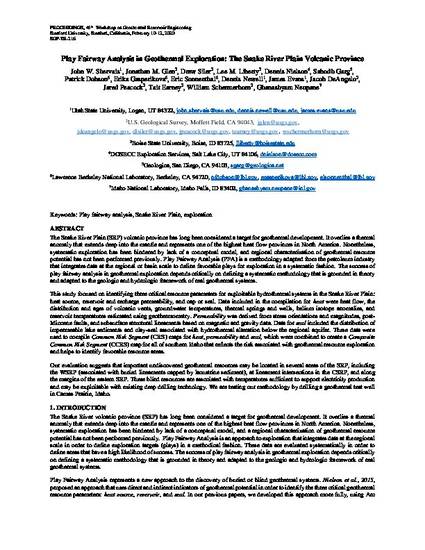
Article
Play Fairway Analysis in Geothermal Exploration: The Snake River Plain Volcanic Province
PROCEEDINGS, 45th Workshop on Geothermal Reservoir Engineering
(2020)
Abstract
The Snake River Plain (SRP) volcanic province has long been considered a target for geothermal development. It overlies a thermal anomaly that extends deep into the mantle and represents one of the highest heat flow provinces in North America. Nonetheless, systematic exploration has been hindered by lack of a conceptual model, and regional characterization of geothermal resource potential has not been performed previously. Play Fairway Analysis (PFA) is a methodology adapted from the petroleum industry that integrates data at the regional or basin scale to define favorable plays for exploration in a systematic fashion. The success of play fairway analysis in geothermal exploration depends critically on defining a systematic methodology that is grounded in theory and adapted to the geologic and hydrologic framework of real geothermal systems. This study focused on identifying three critical resource parameters for exploitable hydrothermal systems in the Snake River Plain: heat source, reservoir and recharge permeability, and cap or seal. Data included in the compilation for heat were heat flow, the distribution and ages of volcanic vents, groundwater temperatures, thermal springs and wells, helium isotope anomalies, and reservoir temperatures estimated using geothermometry. Permeability was derived from stress orientations and magnitudes, postMiocene faults, and subsurface structural lineaments based on magnetic and gravity data. Data for seal included the distribution of impermeable lake sediments and clay-seal associated with hydrothermal alteration below the regional aquifer. These data were used to compile Common Risk Segment (CRS) maps for heat, permeability and seal, which were combined to create a Composite Common Risk Segment (CCRS) map for all of southern Idaho that reflects the risk associated with geothermal resource exploration and helps to identify favorable resource areas. Our evaluation suggests that important undiscovered geothermal resources may be located in several areas of the SRP, including the WSRP (associated with buried lineaments capped by lacustrine sediment), at lineament intersections in the CSRP, and along the margins of the eastern SRP. These blind resources are associated with temperatures sufficient to support electricity production and may be exploitable with existing deep drilling technology. We are testing our methodology by drilling a geothermal test well in Camas Prairie, Idaho.
Keywords
- geothermal,
- faults,
- Idaho,
- play fairway,
- basalts
Disciplines
Publication Date
February, 2020
Citation Information
PROCEEDINGS, 45th
Workshop on Geothermal Reservoir Engineering
Stanford University, Stanford, California, February 10-12, 2020
SGP-TR-216
Creative Commons license

This work is licensed under a Creative Commons CC_BY International License.
